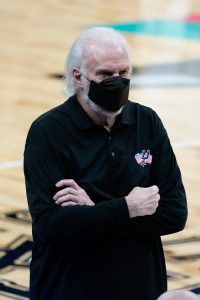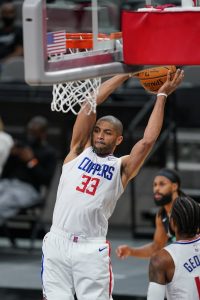Injury issues may have factored into the MVP race more than usual during the pandemic-shortened 2020/21 season, when Nuggets big man Nikola Jokic remained healthier than several other All-NBA talents en route to earning his first MVP award.
Regardless, Jokic turned in an incredible and worthy MVP season. The three-time All-Star center played in all 72 regular season games and averaged an eye-popping 26.4 PPG, 10.8 RPG, and 8.3 APG, on .566/.388/.868 shooting splits, for a Denver team that finished third in the crowded Western Conference with a solid 47-25 record. Can the 25-year-old superstar repeat as the MVP for the 2022 season?
Sixers center Joel Embiid, Warriors point guard Stephen Curry, Bucks forward Giannis Antetokounmpo (the eventual 2021 Finals MVP), and Suns point guard Chris Paul rounded out the list of the top five players receiving the most votes. Prior to incurring significant mid-season injuries, Embiid and Lakers forward LeBron James, a four-time winner, appeared to be the frontrunners for the award last year, alongside eventual victor Jokic.
Antetokounmpo has already won the award twice, in 2019 and 2020. As the best player on the reigning champion Bucks, the 26-year-old appears likely to vie for the honor again next year. Curry was also a back-to-back winner, in 2015 and 2016.
Through the first month of the 2020/21 NBA season, there was a different MVP favorite among media members. Nets All-Star Kevin Durant enjoyed a terrific comeback year in 2020/21 after an Achilles tear kept him sidelined for the entire 2019/20 season. Injuries and load maintenance limited Durant to just 35 regular season games with Brooklyn, however. He certainly looked like the best player on the planet during the Nets’ injury-impeded 2021 playoff run, plus a subsequent march to his third Olympic gold medal with Team USA. The 32-year-old was previously the 2014 MVP while with the Thunder.
Durant’s All-Star teammate James Harden, the 2018 MVP, is normally quite durable, but he missed an unusual amount of time last year with a nagging quad injury. Given that the Nets will field perhaps the most loaded roster in the NBA between Durant, Harden, All-Star point guard Kyrie Irving, and significant depth, one of Durant or Harden seems like a very viable MVP candidate next year.
With 2021/22 returning to an 82-game schedule amidst a much-lengthier turnaround time between seasons than last year, it appears likely that many veteran All-Stars will again be in the running for MVP honors. The aforementioned players all seem like safe bets to be in the mix for the award again this season, assuming good health. James and Paul, the two oldest players among that group, could see their MVP chances hampered by minutes management.
Beyond these usual suspects, other players may find their way into the MVP conversation. Depending on team record and player health, Lakers big man Anthony Davis, Suns shooting guard Devin Booker, Hawks point guard Trae Young, Jazz guard Donovan Mitchell and center Rudy Gobert, Heat swingman Jimmy Butler and center Bam Adebayo, Clippers forward Paul George, Knicks forward Julius Randle, Trail Blazers point guard Damian Lillard and Mavericks point guard Luka Doncic all seem like fringe candidates for MVP consideration.
The crowded Eastern Conference could also see a surprise MVP contender (or, at least, a conceivable top-five finisher in media voting) emerge from several teams hoping to vault up the standings, thanks to active offseasons. Bulls All-Star guard Zach LaVine, Celtics All-Stars Jayson Tatum and Jaylen Brown, and Pacers All-Star center Domantas Sabonis seem positioned to benefit the most from their teams’ summer makeovers, should those changes lead to top-four conference finishes for any of their clubs. In the case of the Pacers, the biggest personnel upgrade may have been on the bench, where the team added longtime Dallas head coach Rick Carlisle to replace one-year Indiana coach Nate Bjorkgren.
We want to hear what you think! Which of these players we mentioned is your way-too-early favorite to win the 2021/22 MVP award? Which young All-Star could move into being a top-five MVP vote-getter for the first time? Is there anyone we haven’t mentioned that you think could work their way into the conversation? Weigh in below in our comments section!

